Episode 214
What you’ll learn in this episode:
- What triggered Gabi’s obsession with spoons
- Why the most elementary shapes are the perfect canvas for exploration
- How Gabi uses wax to create her pieces
- Why Gabi never polishes the spoons she creates, and why there is beauty in imperfection
- Why there is no time limit to study and make jewelry
About Gabi Veit
Gabi Veit is an Italian artist and jewelry designer with a passion for spoons. She lives and works in Bozen/Südtirol/Italia and in Aesch/Zürich/Switzerland. Having grown up in South Tyrol, she creates jewelry that celebrates the rough and jagged shapes and outlines of her home country’s rocks and mountains. Her unique spoons surprise the beholder with unusual shapes borrowed from plant life.
Additional Resources:
Photos:
“Rosengarten” photo by ©Federico Cavicchioli
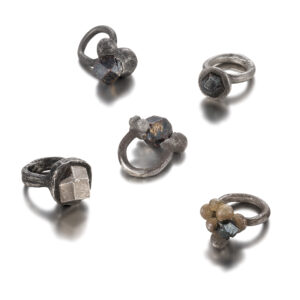
“Deadlysins” ©grassi museum fuer angewandte kunst Photo by: Christoph Sandig
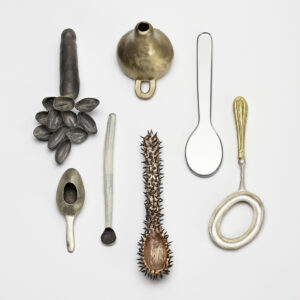
“Creatura” Photo by: Geschoepf_bb
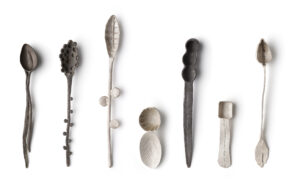
“Capriccio” Photo by: ©Dietlind Wolf
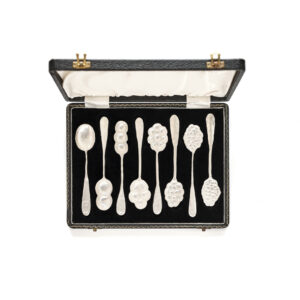
“Creatura” Photo by ©Federico Cavicchioli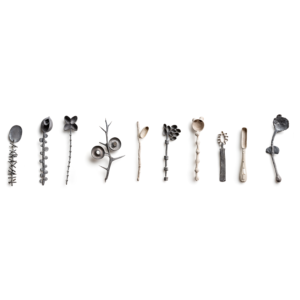
Transcript:
A spoon is one of the most basic objects we have: a line and a circle, designed for everyday use. In this simplicity, jewelry artist Gabi Veit saw a world of possibilities. She joined the Jewelry Journey Podcast to talk about how she started making spoons; why no two of her spoons are alike, even in a set; and why she is living proof that it’s never too late to study jewelry and design. Read the episode transcript here.
Sharon: Hello, everyone. Welcome to the Jewelry Journey Podcast. This is the second part of a two-part episode. If you haven’t heard part one, please head to TheJewelryJourney.com.
Gabi Veit’s work is definitely different than any other you will encounter. She makes jewelry, yes, but for the past few years, she has been very taken with spoons. It’s for a variety of reasons that I will let her tell you about. Welcome back.
Does the museum advertise your work? Do they promote it?
Gabi: Yes, they do. It’s not only my work in this case. There are 50 other artists who are showing their work. This exhibition is made to show the clients, the people, what’s happening now, what artisans and artists are doing at this moment. There are museums for applied art which are doing this. It’s a nice, ambient atmosphere there.
Sharon: Do you ever feel a little envious of what other people are doing? Do you look at their work and think, “I should try that”?
Gabi: It’s very interesting. Maybe because I started so late. I started with jewelry when I was 40. When I entered into this exhibition, when I had the possibility to have this exhibition, it was more, “Oh look, what does she do?” I’m in a wonderland when I’m exhibiting with colleagues, and I’m happy to have the opportunity to be part of this community. I’m more happy than envious. No, I’m not envious. I’m not an envious woman, I think.
Sharon: You don’t seem like you are. You were in advertising and graphic design before this. What made you decide to go into jewelry?
Gabi: I always wear jewelry. I always loved jewelry. When I was 26, I was always thinking about doing an apprenticeship in my region, but they said, “No, you are 26. You are too old to do that.” I believed I was too old, and I did my work. I also founded a theater in my hometown. I was completely—how can say it—I was most happy with my life. There were so many nice things going on in my life that I somehow forgot this wish. Then this wish came again, and I started giving workshops. I was thinking, “Oh, I need to know more. I need to learn the techniques.” So, I went to Florence. I was there for three years at Alchimia to study contemporary jewelry.
Sharon: When you say you gave workshops, did you give workshops in design or jewelry?
Gabi: I was a student of workshops.
Sharon: Oh, O.K.
Gabi: Now, I give workshops, but then I was the student.
Sharon: I read that in 2016, you gave a workshop in Edinburgh with two other Italians.
Gabi: No, this was a symposium. We were invited. Maria Garza, Gigi Mariani and I were invited to go to Edinburgh to meet other artists and to work together for one week. It was an interesting experience for all of us. Then we worked for a year at home, and then we made an exhibition about our experience.
Sharon: What was interesting about the experience? What was interesting to you?
Gabi: For me, it was very interesting that we went to the sea on the first day together. I noticed all the others were familiar with the waves and the sea. I had a lot of respect for the water, and I was also noticing that the water was bringing something. It was bringing shells and also garbage. You can stay there and the water brings you treasures, but if you grow up in the mountains, treasures are never floating directly on your feet. When you are in the mountains, you have to climb them. When you go down, you have to do it by yourself. I was like, “Oh, wow! There is another way to get inspiration.”
Sharon: Did you make some spoons from that idea?
Gabi: I made spoons out of shells I found there.
Sharon: What did they get out of it? What do you think they saw, Gigi Mariani and the other person?
Gabi: It was not the first moment, but it was a very intense moment for us Italians that the sea was also bringing refugees and dead refugees. Gigi and Maria Garza were dealing with these arguments, with these dead bodies and with these people who have the hope to get a better life that sometimes die in the sea. That was their way to look at the sea in this moment.
Sharon: You also make bowls. Two bowls of jewelry, I mean.
Gabi: Yeah.
Sharon: Do your bowls ever go with the spoons? Do you make a set?
Gabi: I’ve never made a set until now. They are good to combine, but I never did it as a combination from the moment I started.
Sharon: Has anybody that collects your things ever commissioned you and said, “I want five spoons and six bowls,” like a dinner set?
Gabi: No, that would be so nice. Please, if I received that, I would like to do that.
Sharon: You would do it?
Gabi: Yes, sure. That’s very interesting. Maybe I can tell the person that the pieces I make are not always the same. If you say, “I want to have 12 spoons,” they are not completely the same. Maybe they are a family, but like in a family, there are different characters. My work is all about unique pieces and not multiples.
Sharon: Do you ever tell people when they say, “What should I do with this? Do you hang it around your neck or a belt or something?” Do they hang it on a wall?
Gabi: Yes, there are a lot of people who say, “Oh, it’s so nice, this spoon. It could be a brooch.” Then I say, “No, sorry, that’s not a brooch, it’s a spoon. If you want to have this as a brooch, I would make it again, not in a spoony way, but in a brooch way. So, it becomes a real brooch, not only an object with—”
Sharon: A pin or something.
Gabi: Yeah. The spoon is born as a spoon. A spoon is a spoon is a spoon. There are people who put my spoons on the table only to look at them, but also on the wall. That happens.
Sharon: Do you have to hold yourself back if you think, “Well, I should polish it more.” A lot of your stuff is oxidized or it’s rough. Do you think, “I should polish it to make it shine”?
Gabi: I never polish. I really don’t polish, never, never. I know that in tableware, traditional spoons are shiny. But when they are made out of silver or sterling silver, they never could stay this shiny because they will oxidize anyhow. It’s impossible to get silver always in the same color and always shiny. I don’t want to go against the material. I like this Japanese idea of beauty, wabi-sabi, where the beauty is not made out of a perfect thing, but it’s made when an object is used, when an object maybe has an error, when an object oxidizes or has a part which is more shiny on one side. I really like this way to treat my work.
Sharon: Did you study in Japan?
Gabi: No. I would like to go to Japan.
Sharon: I know you’ve studied at different places. Where else have you studied besides Switzerland and Italy?
Gabi: I never studied in Switzerland. I studied graphic design in Austria. I studied graphic design also in Venice, in Italy, and then in Florence. I was not in other countries. In Germany, I did some workshops, but no other studies.
Sharon: When people ask you to do workshops, do they want you to show how to do the spoons?
Gabi: They are interested in working with wax, which I show them. There are so many different ways to treat wax. When the outcome is a spoon, I’m happy, but when the outcome is—I don’t know—a necklace part, a ring or an object, that’s also O.K. The participants of my workshop come with different ideas, and this is what I like. Maybe they are intrigued by my spoons or by my jewelry pieces, but it’s about their language and not about my language.
Sharon: Have you ever inspired somebody who has been told they were too old to do it, and then they went on and did it anyway because you went against the grain? Do you ever meet anybody who was told they’re too old to change fields—or not to change fields, but to do this and you’ve inspired them? You’ve said, “No, that’s not true.”
Gabi: I always say to everyone, “It’s not true.” I think you can do everything when you want. It doesn’t need to be radical. It can be an hour a day or an hour a week. You can achieve change or achieve things in many different ways.
Sharon: Why do you say that a spoon is a subject of experimentation and interaction? You’ve said that. Why is that?
Gabi: For me, the spoon is a big field of experimentation. There are moments when I’m having a hike or a walk and I see a spoon everywhere. Somehow, a tree is a spoon formally. It’s about my imagination and what I can see in whatever I watch. I also think the spoon theme is not finished. It never finishes because there are so many possibilities. Maybe that could be an explanation.
Then, for me, spoons are needed for cooking and scooping and eating. Eating in itself is an interaction and communication. I think the best way to talk to each other is to sit around the table and eat together. I’m sure there is at least one spoon.
Sharon: That’s true. What’s the largest? Have you ever made a spoon for a tureen, something large?
Gabi: I’ve made very small pieces, like three centimeters, and also very big ones like, 30 centimeters.
Sharon: What was your attraction initially to the spoon you were designing and advertising? What did you see in the spoon?
Gabi: I think it’s a very simple tool. Maybe it’s one of our first tools that humankind uses. Somehow, our hand is the bowl and our arm is the handle. We have our own spoons with us, but when it’s too hot or too cold, we need a tool. I think from the beginning, people did their own tools, their own spoons. This is so primary, so easy, so simple, which I love very much.
Sharon: Is that what keeps you going? That the spoon, the art jewelry, is never finished? You use a different spoon for everything.
Gabi: Yeah, I think so. I would never do a fork, and I would never do a knife. That’s not interesting for me. The spoon somehow is more interesting.
Sharon: That’s interesting. I didn’t even think of a different tool for you. Would a fork be too difficult?
Gabi: I would find a way to do it, but I’m not interested. I think this simple form attracts me much more than the spikey tree or the five spikes of a fork. I don’t know. It’s not so inspiring for me.
Sharon: Gabi, thank you for being here today and for explaining. It’s a whole table of spoons, and they’re really unusual. I really appreciate your being here today.
Gabi: Thank you very much.
Sharon: Thank you. Well will have photos posted on the website. Please head to TheJewelryJourney.com to check them out.
Thank you again for listening. Please leave us a rating and review so we can help others start their own jewelry journey.

